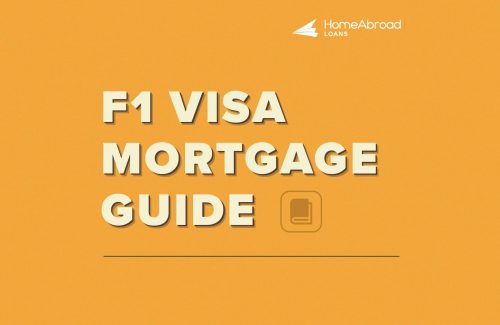Key Takeaways:
➡️ F1 visa holders on Optional Practical Training (OPT) can qualify for a mortgage with HomeAbroad Loans by using their income, credit score, or a co-signer.
➡️ Parent-assisted mortgages allow F1 students to live in properties purchased by their parents, leveraging their foreign income and credit history.
➡️ HomeAbroad Loans offers flexible financing options, enabling F1 students and their families to invest in US real estate, even without a US credit history.
Table of Contents
F1 visa holders have unique opportunities to secure a mortgage in the US, even without a US credit history. Whether you’re earning income during your OPT period or exploring parent-assisted mortgage options, homeownership is within reach.
Take the example of Carlos, an F1 visa student whose parents wanted to invest in a home during his time in the US.
While Carlos couldn’t apply for a mortgage on his own, his parents successfully secured a mortgage with HomeAbroad Loans, allowing Carlos to live in the property during his studies while they built equity.
In this guide, we’ll explore how F1 visa students, whether earning income or not, can use HomeAbroad loans to achieve homeownership in the US.
Can F1 Visa Students Get a Mortgage in the US?
For F1 visa students, the dream of homeownership in the US is more achievable than it might seem. While traditional challenges like limited credit history and income can pose hurdles, there are viable pathways available to make it happen.
Students on F1 visas in their OPT period who have an Employment Authorization Document (EAD) and active US payroll may qualify for a mortgage through HomeAbroad Loans.
With a steady income and a good credit score, an F1 visa holder may also qualify for conventional or FHA (Federal Housing Administration) loans to purchase a home.
F1 Visa Mortgage Options with Good US Credit History
F1 visa holders on OPT who have EAD, have a few options for securing a mortgage. These include:
- FHA Loans: These government-backed loans are an excellent choice for first-time homebuyers. These loans require a minimum credit score (580+) and allow for smaller down payments, making them ideal for those with limited credit history.
- Conventional Loans: Students with a strong credit score (620+) and sufficient income may qualify for conventional loans backed by Fannie Mae or Freddie Mac. While these loans often require a higher down payment, they come with better interest rates.
For F1 visa holders without US income or credit history, a parent-assisted foreign national mortgage may be the best alternative, which we’ll explore next.
F1 Visa Mortgage Options with No/Thin US Credit History
For F1 visa students without sufficient credit or income to secure a mortgage, HomeAbroad Loans offers tailored mortgage programs designed specifically for international students and their families.
These programs allow parents of F1 students to qualify for a loan to purchase a property in the US. The property can serve as the student’s residence during their studies while also generating rental income and potentially appreciating in value over time.
In these cases, the mortgage application is made by the parents, using their income, assets, and credit history from their home country to qualify for a mortgage in the US.
Additionally, HomeAbroad loans offer mortgage options where the parents can qualify based on the rental income potential of the property rather than their personal income without needing a US credit history.
Let’s consider the case of our client, Carlos and his parents, Maria and Juan, to understand how these tailored mortgage programs work.
Case Study: Mexican Student Purchased a Rental Property in Boston, MA
Maria and Juan’s US Real Estate Investment for Carlos, an international student at Northeastern University - Boston, Massachusetts
Carlos is an F1 visa student from Mexico, pursuing his undergraduate degree at Northeastern University in Boston, Massachusetts. He does not earn income in the US and has no credit history, which makes him ineligible for a mortgage.
However, Maria and Juan, his parents, recognized an opportunity to invest in US real estate while also providing housing for Carlos during his studies. They approached HomeAbroad Loans to explore their mortgage options.
These were the options we provided:
1. Full Documentation Loan
Maria and Juan had strong, stable incomes and an excellent credit history in Mexico.
HomeAbroad Loans offers a Full Documentation Loan, allowing them to use their foreign income and assets—such as income statements, bank account details, and credit reports from Mexico—to apply for the mortgage.
In this scenario, HomeAbroad Loans assesses Maria and Juan’s ability to repay the loan based on their foreign income and assets.
By using their solid financial background from Mexico, Maria and Juan are approved for a Full Documentation Loan, securing the property in California where Carlos will live for the next four years.
- Benefits: The property is entirely funded based on Maria and Juan’s financial standing, and they are considered the primary borrowers. Carlos can live rent-free while Maria and Juan gain additional rental income from other tenants and property appreciation.
Loan Requirements:
- Minimum down payment of 25%
- Income/Asset Verification Documents (Paystub from home country if employed, CPA Letter if self-employed))
- Amortization: 15- & 30-Year Fixed Rate and 30 Year Fixed – Interest Only
- Proof of Creditworthiness from home country (Credit report or credit card/other tradeline history from home country, bank reference letter etc.)
- 12 months of Cash Reserves
2. DSCR Loan (Debt Service Coverage Ratio)
Alternatively, Maria and Juan explore another option: the DSCR Loan. Instead of focusing on their personal income, HomeAbroad Loans evaluates the rental income the property can generate.
The key criterion here is that the expected rental income from the property should cover the mortgage payments.
Based on this projected rental income, Maria and Juan qualify for the DSCR Loan with DSCR ratio of 1.26 which means the property generates 26% incremental cash flow after paying for monthly mortgage payment.
- Benefit: The DSCR Loan allows Maria and Juan to purchase the property with less focus on their foreign income and more on the property’s ability to generate rental income.
This means that not only Carlos practically lives rent free during his tenure as an international student, but the property appreciation in 4 years time (length of education) can help build enough equity to cover most if not all the educational expenses.
Loan Requirements:
- DSCR ratio of 0.75 or higher.
- Minimum down payment of 25%
- Amortization: 15- & 30-Year Fixed Rate and 30 Year Fixed Interest Only
- Market rent appraisal or 12 months documented rental income
- 6 Months of PITIA Cash Reserves
Which Loan Option Did They Choose?
After comparing both loan options, Maria and Juan decided to go with the DSCR Loan.
Since the property was located in a high-demand rental area and had strong rental income potential, making the DSCR Loan a more financially beneficial choice.
By focusing on the property’s ability to generate income rather than relying on their foreign income for loan qualification.
With the DSCR Loan, they successfully purchased the property as an investment. Carlos now has a convenient place to live during his studies, while the rental income from other tenants helps offset the mortgage payments, turning the property into a wise financial decision.
The Appreciation Strategy – Using Property Appreciation to Cover Tuition Fees / Expenses
In addition to offering housing for Carlos during his studies, the property also appreciated significantly over four years.
The property’s value increased by nearly 30%, allowing Maria and Juan to leverage the appreciation to cover a substantial portion of Carlos’s college tuition.
Outcome:
➡️ Initial Property Value: $400,000
➡️ Down Payment (25%): $100,000
➡️ Mortgage Amount: $300,000
➡️ Rental Income Over 4 Years:
- Monthly Rent from Other Tenants: $2,000
- Total Rental Income Over 4 Years: $2,000 x 48 months = $96,000
- This income covered a significant portion of the mortgage payments and property taxes.
Appreciated Value After Four Years (30% Increase):
- $400,000 x 1.30 = $520,000
- Appreciation Gain: $520,000 – $400,000 = $120,000
- Carlos’s College Tuition: $120,000 over 4 years
- Net Outcome: The $120,000 appreciation gain matched Carlos’s total tuition costs, effectively making the property investment a strategic financial move that saved Maria and Juan from paying out of pocket for his education. Additionally, the rental income covered most of the mortgage payments
In both scenarios—whether through a Full Documentation Loan or a DSCR Loan—HomeAbroad Loans provides tailored solutions for parents seeking to invest in US real estate while providing housing for their children during their studies.
In Maria and Juan’s case, the DSCR Loan proved to be the ideal choice. It not only provided Carlos with rent-free accommodation but also helped the family manage significant expenses like college tuition through steady rental income and property appreciation.
Steps to Get a Mortgage on an F1 Visa with HomeAbroad Loans
Securing a mortgage for F1 visa holders or their parents is a seamless process with HomeAbroad Loans. Here’s a quick step-by-step guide to getting started. For a more detailed breakdown, check out our comprehensive Foreign National Mortgage Guide.
- Step 1 – Get Started with HomeAbroad Loans
- Step 2 – Connect with a HomeAbroad Mortgage Officer
- Step 3 – Get Preapproval
- Step 4 – Gather Your Documents
- Step 5 – Make an Offer on Your Dream Home
- Step 6 – Lock in Your Interest Rate
- Step 7 – Underwriting & Appraisal
- Step 8 – Closing
If you are an F1 visa holder or a parent looking to buy property in the US, HomeAbroad Loans can help. We offer tailored mortgage programs for international buyers. Whether you’re on OPT looking to buy your first home or a parent investing in real estate for your child’s future, HomeAbroad Loans can guide you through the process.
FAQs
Can F1 visa holders get a mortgage without a credit history?
Yes, if they’re on OPT with income and a co-signer or through a parent-assisted mortgage using their parents’ foreign income and credit with HomeAbroad Loans.
What mortgage options are available for international students?
FHA loans and Conventional loans are available to F1 students who are generating income in the US. Also, parent-assisted mortgages – Full Documentation Loans and DSCR Loans are available through HomeAbroad Loans.
Can my parents buy a house for me while I’m on an F1 visa?
Yes, parents can purchase an investment property for their child using their income and credit history from their home country through HomeAbroad Loans.
Do F1 visa holders need an EAD to qualify for a mortgage?
Yes, F1 students will need an EAD to prove income and employment during OPT to qualify for a mortgage with HomeAbroad Loans.
Can international students get a mortgage if they have student loan debt?
Yes, HomeAbroad Loans offer DSCR Loan which allows qualification based on the rental income potential of the property, ignoring the borrowers debt-to-income ratio.


















